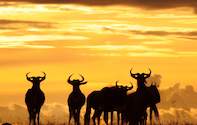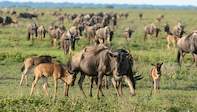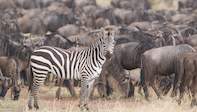
The Great Migration
Almost two million animals move across the Serengeti and Mara plains in search of food and water. Facing multiple dangers such as land predators and crocodiles the wildebeest complete an 800 km round trip during the migration.The herds move from the southern plains of the Serengeti, through the western section into the Masai Mara in Kenya where they roam for a few months before heading south into the Serengeti again. But where does the migration start and where does it end? This is a bit like the chicken and the egg argument as the great migration is a continuous movement of animals throughout the year.
If pushed the answer would probably be that the Great Wildebeest Migration starts in the southern plains of the Serengeti as this is where the females give birth and also where the herds spend more time than anywhere else.
Heading North

When the water and grass begins to dry up on the southern plains, the herds begin to move north across the western section, also known as the Western Corridor, of the Serengeti. En route they have to cross the Grumeti River - where Africa's largest crocodiles await. Many of the animals are killed by crocodiles or drowned in the stampede across the river.
The herds cross into Kenya's Masai Mara in the latter part of the year where they spend up to two months before heading south again to the fertile southern plains of the Serengeti. During their time in the Mara they will have to make a few river crossings where again crocodiles lie in wait.
The Second Migration and Predators
There is a smaller migration of wildebeest into the Mara from the northern Loita plains. Numbering around 150 000 these animals are not part of the main migration and may not even come into contact with the herds of the great migration.The herds are under continual threat en route from predators. These predators do not follow the herds as once thought but rather the herds are constantly in the home ranges of predators giving the impression that predators are following.
Clarifying the Great Wildebeest Migration

t is presumed by some visitors that a safari to the Serengeti in Tanzania or the Masai Mara in Kenya at any time of the year will provide the opportunity to experience the migration. This is not true as the herds are on the move and they are only in particular areas for limited periods.
The Great wildebeest Migration is controlled by the availability of food and water and for this reason the movement of the herds cannot be predicted. Some years they may cross into the Masai Mara as early as July whereas at other times they may only cross in late August.
The animals do not move as one super herd but rather as a collection of herds - and they do not necessarily follow the exact routes of the other herds. Movement depends on the availability of food and water. The Serengeti and Masai Mara are amazing wildlife destinations even when the migrations have passed.
Is There a General Pattern to the Migration?
As the Migration depends on the availability of food and water times cannot be measured too closely but there is a general rule to follow. The herds will be ranging the plains of the southern Serengeti from as early as November, but usually from mid-December, to early may when they will head north through the western corridor reaching and crossing the Grumeti River in June/July.The herds can reach the Masai Mara as early as late July but in general they will cross in August / September where they will spend some time before heading south again from November through to December.

 Great Migration Safaris in East Africa will undoubtedly take a nature lover’s passion for wildlife to a new unprecedented level....
Great Migration Safaris in East Africa will undoubtedly take a nature lover’s passion for wildlife to a new unprecedented level.... For a Great Migration safari, Olakira Camp is in the heart of it all on the Ndutu plains from December to March. The mobile camp moves to th...
For a Great Migration safari, Olakira Camp is in the heart of it all on the Ndutu plains from December to March. The mobile camp moves to th...